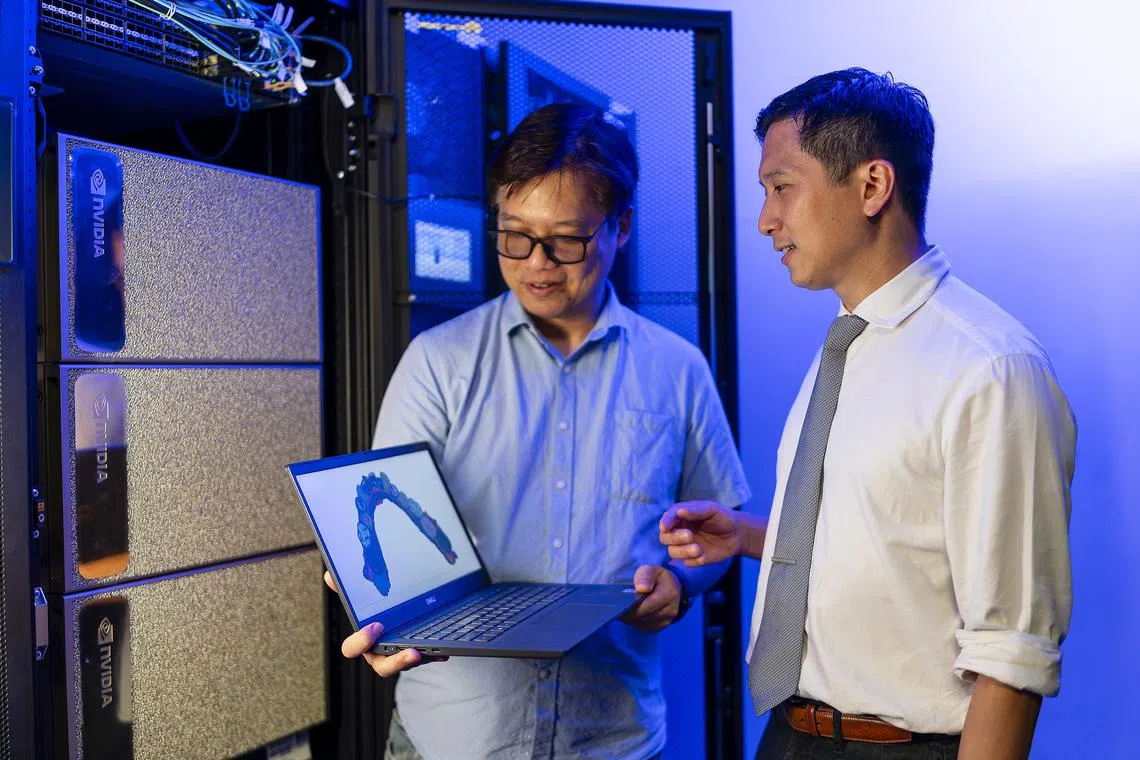Supercomputer at NUHS powers AI projects that save time and give patients better care
Sign up now: Get ST's newsletters delivered to your inbox

NUHS Academic Informatics Office manager Loh Dat Wei (left) showing NUHS group chief technology officer Ngiam Kee Yuan a 3D teeth model made possible with the supercomputer.
PHOTO: NUHS
Follow topic:
SINGAPORE – A day in the life of healthcare staff of the National University Health System (NUHS) will soon be very different, and patients could benefit from quicker care.
Instead of spending time writing referral letters for patients, doctors will be able to tap the healthcare cluster’s version of ChatGPT to do the task, allowing them to dedicate more time to patients.
Staff can also better allocate resources when they use artificial intelligence (AI) to estimate a patient’s length of stay in hospital – much like how hotels have precise information on room occupancy rates.
Powering all these advancements is Singapore’s third national supercomputer,
Called Prescience, the supercomputer has been operational since July 31, after NUHS and the National Supercomputing Centre Singapore inked an agreement to develop it on Dec 3, 2021. The support it provides to hospital staff is expected to be gradually rolled out by the end of 2023.
Supercomputer systems are extremely powerful and can process complex tasks such as large-scale AI and machine learning, enabling rapid analysis and learning from large, complicated sets of data.
Singapore’s first such computer, Aspire 1, was set up at Fusionopolis in 2016. The second, Aspire 2a, has been operational at the National University of Singapore since July 2023. Both are used for a broad range of research in areas such as climate change, weather monitoring, urban planning, healthcare and materials.
Prescience is dedicated to healthcare and medical research.
It enables researchers to use medical big data to train large language models (LLMs) for Singapore’s healthcare needs.
LLMs are deep-learning algorithms that can recognise, summarise, translate, predict and generate content based on knowledge gained from massive data sets.
NUHS’ version, called NUHS Russell-GPT, can summarise patient case notes and write referral letters for doctors in seconds.
Anonymous clinical data and curated clinical guidelines, protocols and data sets are used to train the NUHS model.
This AI model also allows NUHS staff to ask questions, such as those related to medical conditions and clinical practice guidelines, to aid them in their work.
Associate Professor Ngiam Kee Yuan, group chief technology officer of NUHS, said: “From synthesising precise local medical knowledge to reducing the administrative work of our doctors and nurses, this LLM will bring benefits to both healthcare workers and patients.”
The new supercomputer is also being used in another AI project to forecast a patient’s healthcare journey through the analysis of historical data. Approximately 250,000 patients’ anonymous data sets involving their healthcare journeys are used to train the forecast model.
Research is under way to use this model to predict the severity and trajectory of common conditions, such as urinary tract infections. This is to help hospitals decide the most appropriate level of care for patients and better tailor treatment and allocate resources.
Another initiative made possible with Prescience is Smile AI, which involves smart monitoring and intelligent learning aimed at enhancing oral healthcare. Its objective is to help improve patients’ experience.
In the project, dental scans will be used to create three-dimensional teeth-charting models for patients. Such models show the condition of the patients’ teeth and their positions in the mouth. They replace manual records of such data that dentists have to chart.
Instead of a patient waiting for up to a day to get a dental cast done, it will take no more than five minutes for dentists to scan the patient’s teeth and collect information to initiate treatments.
Dr Peter Yu, a senior consultant at the prosthodontics department in the National University Centre for Oral Health, Singapore (NUCOHS), said: “Dental treatments involve three-dimensional appreciation of facial structures, anatomy, reconstruction and a vision of what a patient’s teeth could be after treatments. This supercomputer, with its significant graphic capabilities, is particularly suited for this structural approach.”
To date, 400 3D dental scans of anonymous patients, from children to adults, have been collected to train the AI model.
Under the Smile AI project, X-rays of the upper and lower jaws, or what are known as dental panoramic tomograms, will be collected to predict gum disease.
So far, 200 dental panoramic tomograms of anonymous patients, the majority with gum disease, have been collected.
Dr Wilson Lu, a consultant at the department of orthodontics in NUCOHS, said the gum disease prediction model has the potential to be implemented on a population level so that a patient’s risk of developing gum disease can be classified as low, medium or high, and interventions can be recommended before the onset of disease.
Dr Lu said: “We have a vision that the future of dental care will be data-driven and precisely tailored to the individual based on information on health determinants and oral conditions. Dental care will focus on preventing diseases before they happen, and early detection and treatment of diseases when they happen.”


